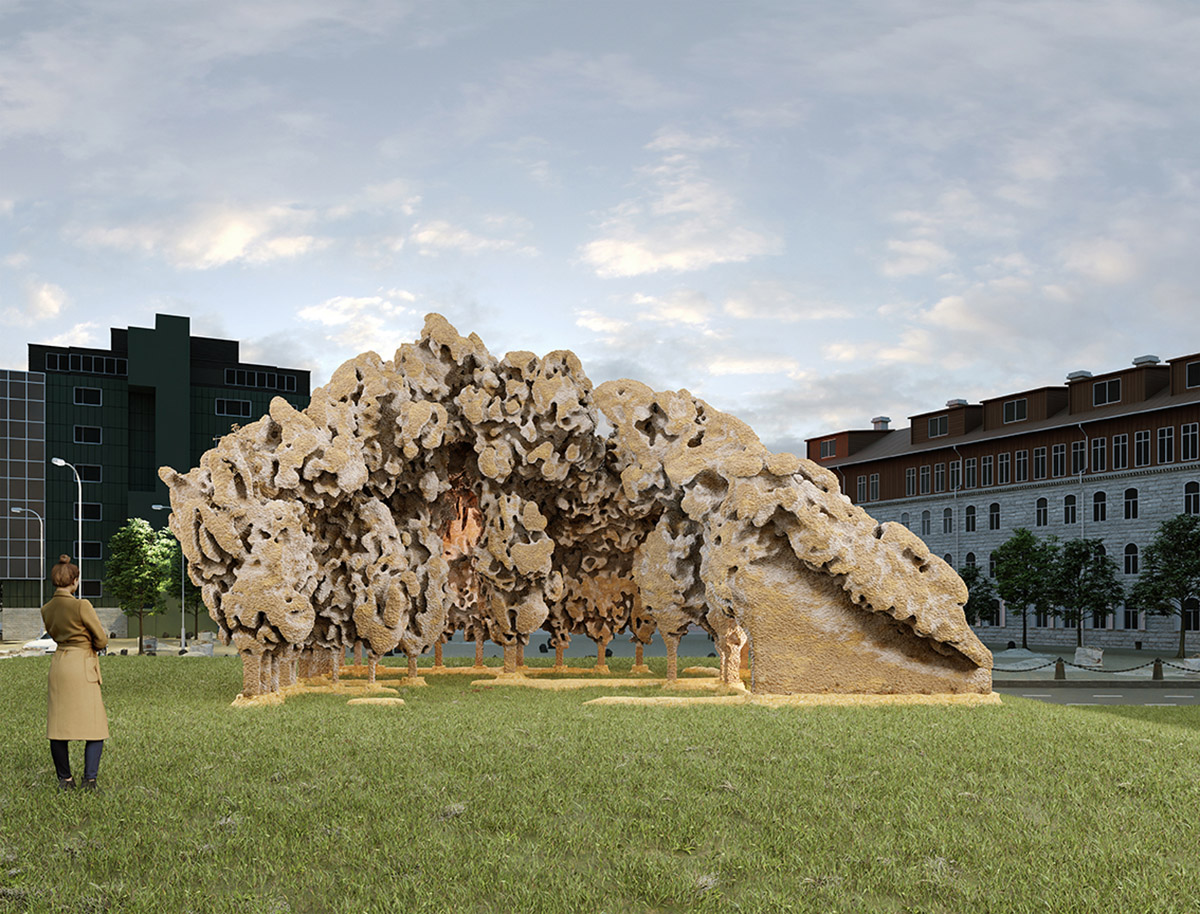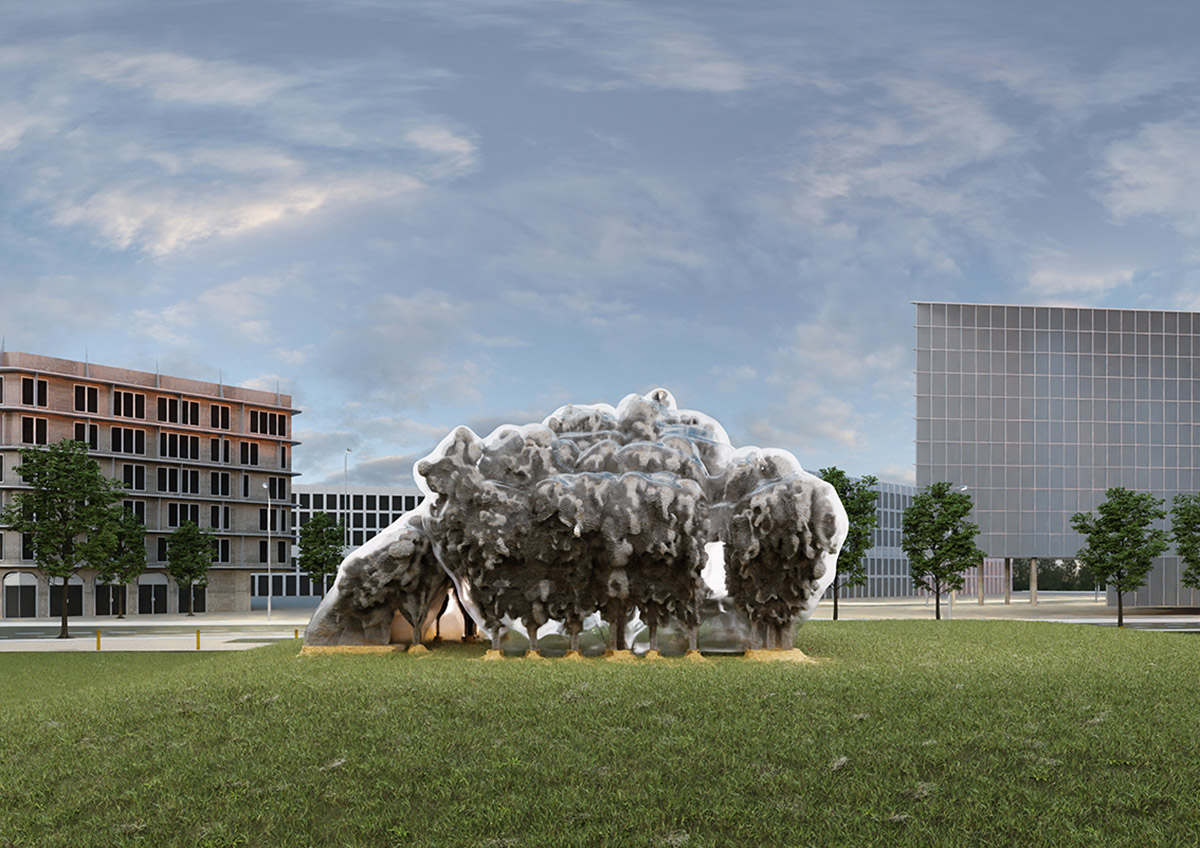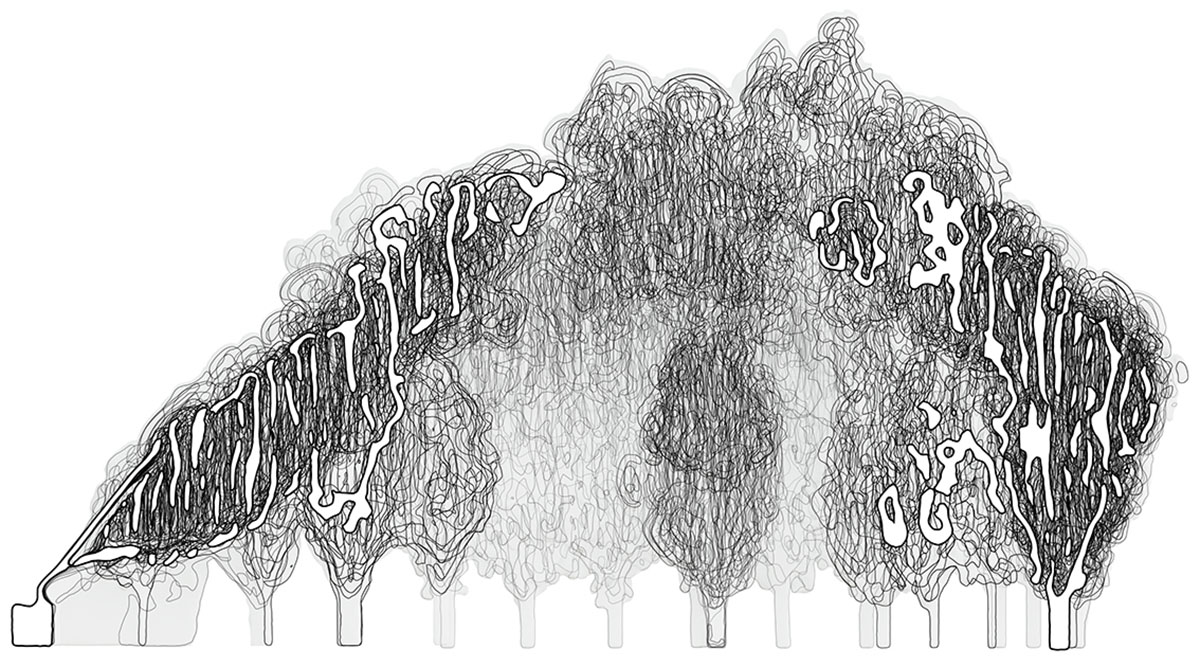Submitted by WA Contents
Simulaa and Natalie Alima's TAB 2022 project solves dualities between erosion and emerging form
Estonia Architecture News - Oct 08, 2021 - 15:38 4749 views

Simulaa and Natalie Alima's winning proposal, titled Burlasite, has been named as the winner of the 6th Tallinn Architecture Biennale (TAB 2022) Installation Programme Competition “Slowbuilding”.
Opened in March 2021, the open two-stage competition challenged emerging architectural talents to design an experimental timber installation in front of the Museum of the Estonian Architecture, in the heart of Tallinn, Estonia.
The competition focused on the concept of slowness and aligning with TAB 2022’s main theme: "Edible. Or, the Architecture of Metabolism".
The project, conceived as a biodegradable material, is driven by algorithmic processes that "enable biological transformations of material growth and decay to rewire its foundations."
This approach helps to understand the specific material process on how to work in large-scale building constructions in the future, while avoiding producing waste at site.

View looking towards the Museum of Estonian Architecture. Image © Simulaa
Simulaa and Natalie Alima's winning proposal was selected from the grand jury comprised of Roland Snooks, Kokkugia, RMIT – Australia, Kathrin Dörfler, dorfundrust, TU Munich – Germany and Peeter Pere, Peeter Pere Arhitektid – Estonia.
Selected from among 119 submissions from around the world, the jury was intrigued by the applicants' proposal of a temporal installation that is cultivated, incubated and cured over several months, engaging perfectly with the curatorial theme “Slowbuilding”.

View looking South into the interior of the installation. Image © Simulaa
A structure that allows for the passing of time to be expressed
Focusing on the lifecycle of the material and beyond the everyday concerns of maintenance and longevity, the winning team "challenges and inverts the prevailing view that a decayed building is an obsolete one – by creating a structure that allows for the passing of time to be expressed."
The project utilizes algorithmic processes that enable biological transformations of material growth and decay to rewire its foundations.
Made of industrial timber waste, the robotically fabricated formwork is inoculated with mushroom fibers that over time, consume and overwrite it with a hardened mycelial structure. This generates a tension between the natural and artificial, heightening the installation's expression of eroding and emerging form.

Mycelia growth study. Image © Simulaa
Investigating timber as a sculpted, textured and imprecise material, the project assigns value to the waste and by-products (off cuts and saw dust) that are commonly discarded.
"Waste material from the local timber industry will be harvested and combined with a biodegradable polymer, forming the base form of the installation; which will be shaped into a series of smaller components, produced using a large, custom 3-axis machine assembly," said Simulaa and Natalie Alima.

Installation contained within ‘incubation bag’ to create ideal conditions for mycelial growth. Image © Simulaa
A new approach can be applied to large scale building manufacturing
The future of materials is one of the most speculative issues in today's architecture and construction industry as the today's construction methods are shifting towards non-waste production processes.
In this regard, Simulaa with Natalie Alima have invented a new approach by combining robotically placed biodegradable binder with hand filling, packing and checking processes, which can be applied to large scale building manufacturing.
Since the process eliminates the need for moulds, the project generates no waste and is completely biodegradable.

Mycelium inoculation kit. Image © Simulaa
The team added that "the 3D-printed timber structure is then inoculated with mycelia to consume and take over, slowly replacing it over time, until the sawdust formwork has been consumed, with only the hardened structural mycelia remaining."
"This is analogous to the process by which bio-scaffolds are utilized in medicine to promote the growth of human tissue with an artificially introduced structure."
"Explicitly engaging with metabolism and the life cycles of materials, the pavilion dies as it becomes permanent."

Incubated 3D printed model inoculated with mycelia. Image © Simulaa
The installation will be built from May to September 2022, in the lively pedestrian green area facing the Museum of Estonian Architecture and will open to the public during the TAB 2022 Opening Week on September 7th, 2022.

3D printed model study. Image © Simulaa

3D printed model study. Image © Simulaa

Studies of artificial growth on Heidegger’s deconstructed hut to create ideal conditions for mycelium growth. Image © Simulaa

Section illustrating the ‘forest’ like qualities of the installation. Image © Simulaa
The structure will remain in place until the next edition of the event in 2024. On the podium stand are second prize winners IHEARTBLOB (UK) with their project Fungible, Non-Fungible.
All the projects by Stage II participants will be displayed at the TAB Installation Programme exhibition, and published on the TAB 2022 website and in the catalogue.
Project facts
Burlasite design: Simulaa with Natalie Alim
Burlasite project team: Andre Bonnice, Anna Jankovic, Bryn Murrell, Tommaso Nervegna-Reed (Simulaa) and Natalie Alima
Burlasite time frame: May – September 2022 – construction
September 7th, 2022 – opening: Tallinn Architecture Biennale 2022, TAB 2022 / "Edible; Or, The Architecture of Metabolism"
Opening week: September 7th – 11th, 2022
Dates: 7th – October 31st, 2022
Head Curators: Lydia Kallipoliti, Areti Markopoulou
Co-curator: Ivan Sergejev
Production: Eve Arpo (Estonian Centre for Architecture)
Top image: Detail view demonstrating textural qualities of the final mycelial colony. Image © Simulaa
> via TAB
